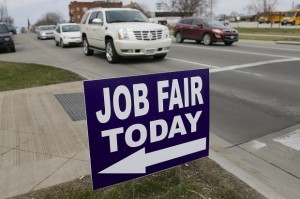5 cautionary signs tucked into April’s jobs report

In this April 10, 2014, photo, a sign points to a job fair on the campus of Kaplan University in Lincoln, Neb. At first glance, April’s US employment report suggested that the agonizingly slow 5½-year-old economic recovery has gained new momentum. Yet several cautionary signs emerged from the report. AP
WASHINGTON— Employers added a sizable 288,000 jobs in April.
Hiring in February and March was better than first thought.
The unemployment rate plunged to 6.3 percent from 6.7 percent.
At first glance, Friday’s US jobs report suggested that the agonizingly slow 5-year-old economic recovery had burst into a full sprint.
Yet several cautionary signs emerged from the report, starting with that spectacular plunge in the unemployment rate.
Article continues after this advertisementHere’s why: The government uses two surveys for the jobs report. The job gain comes from a survey of businesses, the unemployment rate from a survey of households.
Article continues after this advertisementThe survey of businesses showed 288,000 more jobs. Yet the household survey, in calculating unemployment, found that 73,000 fewer people had jobs.
Why did the unemployment rate sink? Because only 806,000 people were in the workforce. Many retired or ended their job hunts. And fewer-than-expected people began looking for work.
The unemployment rate typically drops when fewer people seek work: If they’re not hunting for a job, they’re not counted as unemployed.
All of which points to an underlying weakness in an otherwise improving job market.
“When you have a robust economy, you don’t get these mixed messages,” said Douglas Holtz-Eakin, a former head of the Congressional Budget Office and now president of the conservative American Action Forum.
Here are five cautionary signs from April’s jobs report:
543,000 FEWER PEOPLE SEEKING WORK
Let’s dive a bit deeper into that unemployment rate. People flow into and out of the job market each month. Some leave for school; others return, armed with a degree. Some quit raising a family. Some apply for jobs after their kids start kindergarten. In April, the number of people who began looking for work fell off a statistical cliff.
This suggests that the recovery lacks the kind of gravitational force needed to draw more workers back into the fold. Just 58.9 percent of the working-age population holds a job. That’s down from 62.9 percent before the recession began at the end of 2007.
“We do not yet have a jobs recovery that is strong enough to really pull people in,” said Heidi Shierholz, an economist at the progressive Economic Policy Institute.
The number of people who began seeking work for the first time fell 126,000 from March to roughly 1 million. The figure for new grads and parents who began looking was even bleaker: Down 417,000 to 2.6 million.
If those 543,000 people combined had all started looking for work in April, the unemployment rate would be 6.6 percent — a dip from March’s 6.7 percent, rather than the plunge to 6.3 percent.
NO HOUSING REBOUND
Builders added 32,000 workers in April. But just 41 percent of them were for constructing homes. That share is usually around 50 percent. The lower figure likely reflects how much housing has cooled this year after a solid improvement in 2013. Sales of new homes plunged 14.5 percent last month, according to the Commerce Department.
Friday’s report suggested that homebuilding could remain sluggish.
“You see that in the hiring numbers,” said Steve Blitz, chief economist at ITG Investment Research. “You see it in the borrowing numbers. And you see it in the value of private construction put in place.”
HIGH SCHOOL GRADS AND DROPUTS LOSING OUT
People who’ve never been to college — about a third of workers older than 25 — are struggling. More than 200,000 high school drop-outs lost jobs last month. So did 276,000 high school graduates. This group isn’t sharing in a recovery in which college has become practically a pre-requisite. Only 54.3 percent of high school grads either have a job or are looking for one. That’s down from roughly 60 percent before the recession.
FLAT WAGES
Average weekly paychecks didn’t budge in April. They were $838.70, exactly as in March. Stagnant pay could slow growth, since about 70 percent of economic activity comes from consumers. They can’t ramp up spending unless their wages rise. “Firms are hiring again, but we still need wages to rise faster if the economy is to really accelerate,” said Joel Naroff, president of Naroff Economics.
45,000 MORE MEN WORKING TWO FULL-TIME JOBS
Imagine juggling two-full time jobs. About 198,000 men managed this balancing act last month — a sharp increase of 45,000 year-over-year. True, that’s a small share of the 145.7 million working Americans. But it reveals something critical in an economy in which several million Americans can’t land one job, let alone two.
The number of Americans with two full-time jobs usually rises when times are flush and reliable employees are hard to find. That’s not true now. Nearly 3.5 million people have been jobless for more than six months. When people take a second job, they do benefit financially as individuals. Yet it means someone else is stuck on the unemployment rolls without any job. The trend suggests that many employers are writing off some of the unemployed in favor of those already holding a job.
“That’s 45,000 other people who didn’t get a job,” said Shierholz of the Economic Policy Institute.
RELATED STORIES
3,000 get hired on the spot at job fairs
US embassy organizes local jobs fair for Filipinos —DoLE
US added surprisingly strong 204,000 jobs in October